Texas is home to various bird species, including an impressive array of finches. From the charismatic House Finch to the subtly colored Pine Siskin, these birds are a sight to behold. But with so many species to identify, it can be overwhelming for birdwatchers and nature enthusiasts. That’s where the Discover the Diversity: Finches in Texas (Identification Guide) comes in handy.
This comprehensive guide provides all the information needed to identify the various finch species in Texas. Using detailed descriptions and high-quality photographs, it’s easy to distinguish between similar-looking species and appreciate the unique qualities of each bird.
This guide covers them all, from the commonly seen American Goldfinch to the elusive Evening Grosbeak. It’s a helpful tool for birdwatchers and school groups looking to learn more about the diverse wildlife in Texas.
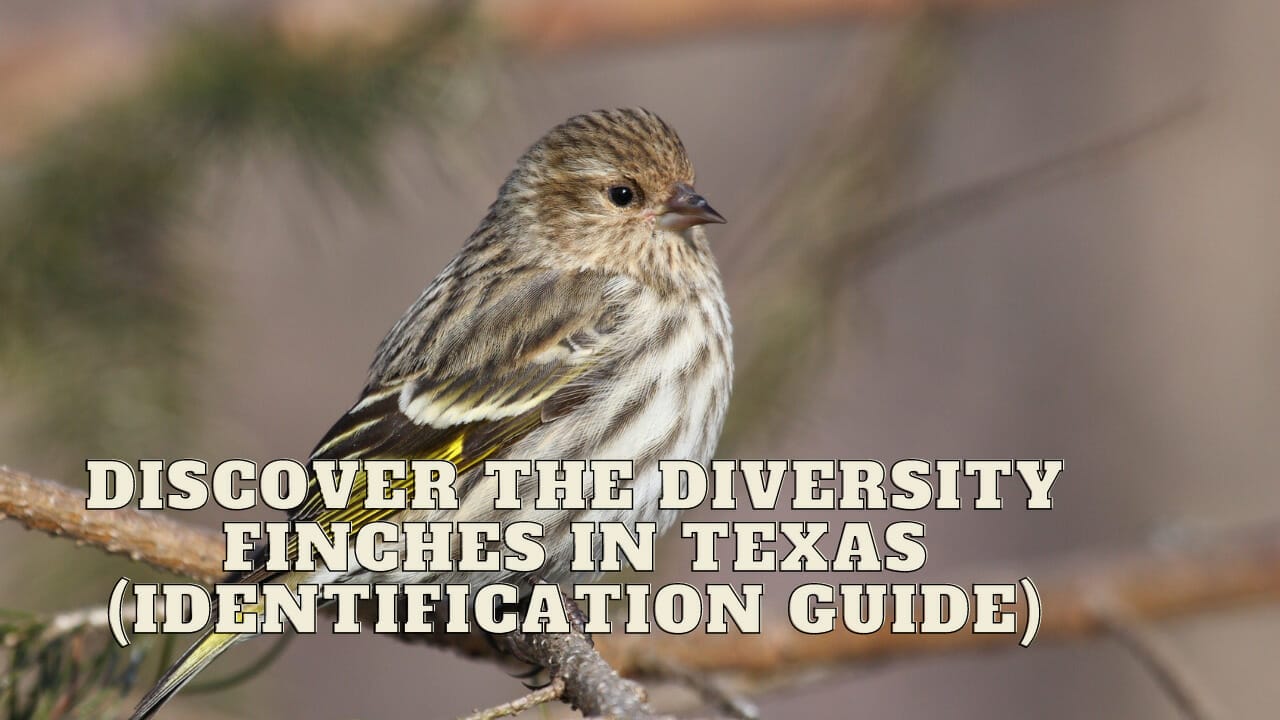
Finches in Texas
So grab your binoculars and get ready to Discover the Diversity: Finches in Texas (Identification Guide).
Finches in Texas
- House Finch (Haemorhous mexicanus)
- Cassin’s Finch (Haemorhous cassinii)
- Lesser Goldfinch (Spinus psaltria)
- Purple Finch (Haemorhous purpureus)
- Red Crossbill (Loxia curvirostra)
- Pine Siskin (Spinus pinus)
- American Goldfinch (Spinus tristis)
- Evening Grosbeak (Hesperiphona vespertinus)
- Juvenile Black-headed Grosbeak(Pheucticus melanocephalus)
- Blue Grosbeak (Passerina caerulea)
- Rose-Breasted Grosbeak (Pheucticus ludovicianus)
- Common Redpoll ( Acanthis )
House Finch (Haemorhous mexicanus)
The House Finch, also known as Haemorhous mexicanus, is a small bird with a unique mixture of colors that make it stand out amongst the rest. This bird species belongs to the family Fringillidae, which includes other finches, crossbills, and siskins. They are known for their ability to adapt to various environments and sweet warbling songs.
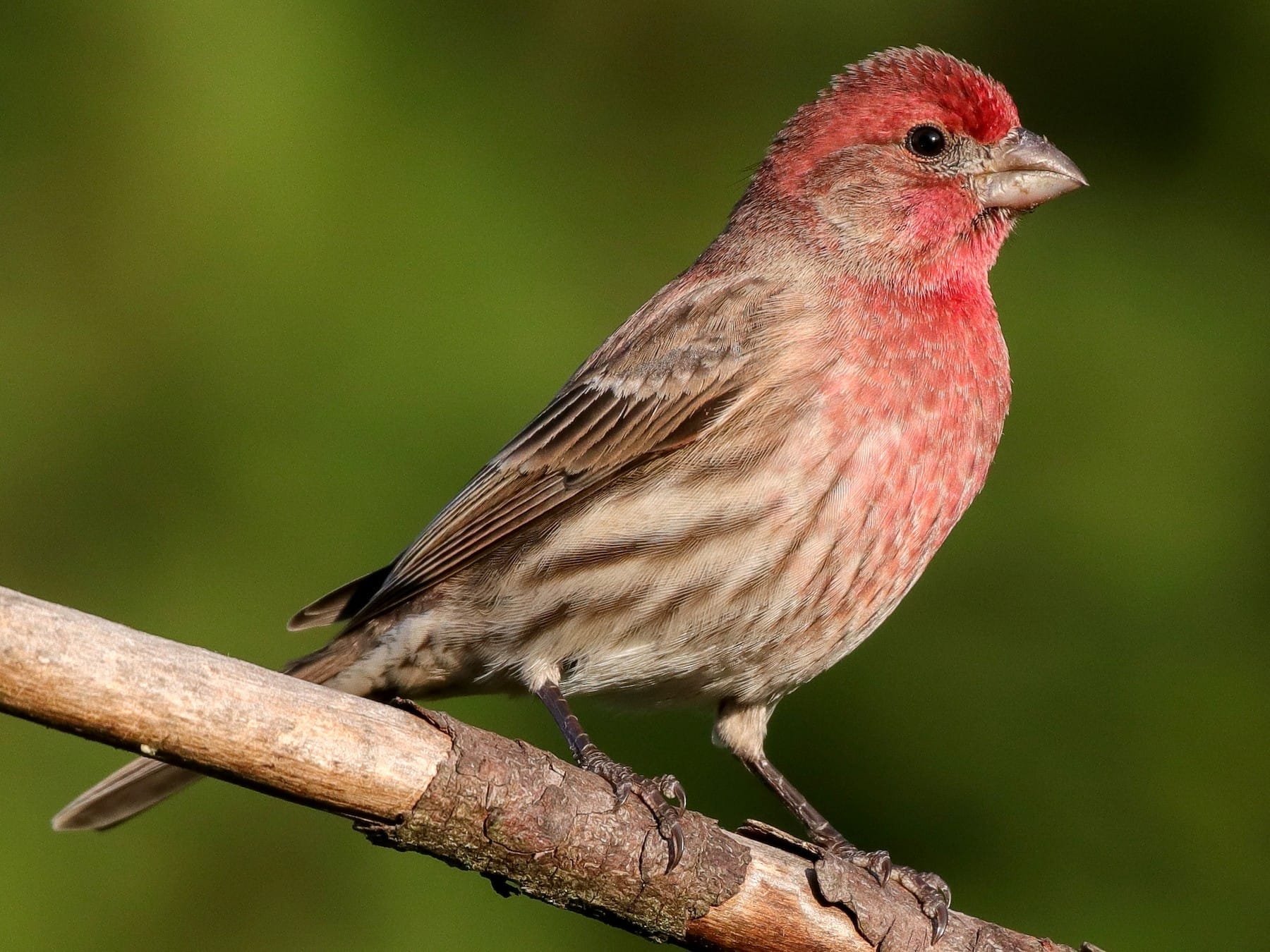
what is the south carolina state bird
Found across North America, House Finches are known to dine on various prey, including seeds, fruits, and insects. These birds have a special beak designed to crack open tough seed shells, making them a valuable part of their ecosystem.
One fun fact about House Finches is that the males have distinct bright red coloring on their heads and chests that are used to attract mates. On the other hand, the females have more subdued coloring, making it easier for them to blend in with their surroundings.
The estimated population size of House Finches is around 267 million, and they are not a species of conservation concern. However, their biggest threat is habitat loss due to urban development and deforestation.
The most distinctive feature of the House Finch is its unique coloration, which includes a brownish-gray body that is accentuated by bright red coloring on the males. Other names for the House Finch include the Linnet and the Redhead.
The wingspan of House Finches can reach up to 8.6 inches, and their incubation period lasts around 12-14 days. Their habitat ranges from forests to deserts, but they are most commonly found in urban areas where they can easily find food sources. Predators of these birds include domestic cats, hawks, and snakes, among others.
As mentioned, House Finches primarily feed on seeds, fruits, and insects, and their diet varies depending on the season and their habitat. They are a type of passerine bird, which means they are perching birds with three toes pointing forward and one pointing backward.
There are seven species of House Finches, all of which can be found in North America. These birds are typically seen in areas such as backyards, parks, and along the sides of roads, and they can nest in various locations, including trees, bushes, and even birdhouses.
The average lifespan of House Finches is about 2-3 years, and they typically molt during their first autumn. They can weigh anywhere from 0.6-0.8 ounces and have a length of 4.9-5.5 inches. These birds are known for their beautiful coloring and gentle demeanor, making them a favorite among birdwatchers and nature enthusiasts.
| Property | Information |
|---|---|
| Common Name | House Finch |
| Scientific Name | Haemorhous mexicanus |
| Family | Fringillidae |
| Habitat | Forests, deserts, urban areas |
| Diet | Seeds, fruits, insects |
| Predators | Domestic cats, hawks, snakes, among others |
| Coloration | Brownish-gray body with bright red coloring on males |
| Other Names | Linnet, Redhead |
| Population Size | Approximately 267 million |
| Conservation Status | Not a species of conservation concern |
| Threats | Habitat loss due to urban development and deforestation |
| Wingspan | Up to 8.6 inches |
| Incubation Period | 12-14 days |
| Diet Variation | Seasonal and habitat-dependent |
| Passerine Bird | Yes |
| Nesting Locations | Trees, bushes, birdhouses, various locations |
| Average Lifespan | 2-3 years |
| Weight | 0.6-0.8 ounces |
| Length | 4.9-5.5 inches |
| Distinctive Features | Unique coloration, special beak for cracking seed shells |
| Mating Behavior | Males use bright red coloring to attract mates |
| Molting | Typically during the first autumn |
| Popular Among | Birdwatchers and nature enthusiasts |
Cassin’s Finch (Haemorhous cassinii)
The Cassin’s Finch (Haemorhous cassinii) is a fascinating species of bird that can be found across the western regions of North America, from Canada to Mexico. Known for its distinctive features and stunning plumage, this member of the finch family is a beloved sight for bird enthusiasts and nature lovers alike.

texas finch bird
Also referred to as the rose finch, the Cassin’s Finch is named after John Cassin, a renowned 19th-century ornithologist. This bird’s scientific name, Haemorhous cassinii, pays homage to his contributions to the study of avian species.
Cassin’s Finches feed mostly on seeds and insects for their diet and can often be found in coniferous or mixed forests and suburban areas. With an estimated population size of approximately five million, these birds are not considered at risk for extinction. However, habitat loss and degradation pose the biggest threat to their population sustainability in the long-term future.
One of the Cassin’s Finch’s most distinctive features is their colorful plumage, with males displaying a bright pink-red head and throat and both sexes having a streaked brown body. Their wingspan typically ranges from 8 to 10 inches, and they can weigh up to 0.8 ounces, with a length of 5 to 6 inches.
These birds typically nest in coniferous trees or shrubs; their incubation lasts approximately two weeks. Cassin’s Finch chicks typically molt at about 7-10 days old and will reach full maturity at around six months of age. Their skin type is covered with feathers, and they can reach speeds of up to 25 miles per hour in flight. Their lifespan ranges from 2 to 4 years in the wild.
All in all, Cassin’s Finch is a stunning and interesting bird species that is worth learning a bit more about. It’s distinctive plumage and unique behaviors make it a beloved sight for birdwatchers and nature enthusiasts across its North American range.
| Species Name | Cassin’s Finch (Haemorhous cassinii) |
|---|---|
| Common Name | Cassin’s Finch, Rose Finch |
| Scientific Name | Haemorhous cassinii |
| Habitat | Western regions of North America |
| Range | Canada to Mexico |
| Diet | Seeds and insects |
| Population Size | Approximately five million |
| Conservation Status | Not considered at risk for extinction |
| Threats | Habitat loss and degradation |
| Plumage | Males: Bright pink-red head and throat |
| Both sexes: Streaked brown body | |
| Wingspan | 8 to 10 inches |
| Weight | Up to 0.8 ounces |
| Length | 5 to 6 inches |
| Nesting Habits | Coniferous trees or shrubs |
| Incubation Period | Approximately two weeks |
| Chick Molting Age | 7-10 days old |
| Maturity Age | Around six months |
| Skin Type | Covered with feathers |
| Flight Speed | Up to 25 miles per hour |
| Lifespan | 2 to 4 years (in the wild) |
Lesser Goldfinch (Spinus psaltria)
The Lesser Goldfinch, known by its scientific name, Spinus psaltria, is a fascinating bird species across North America. This diminutive finch is known for its beautiful plumage, as well as its unique behaviors and habits. This article will explore the Lesser Goldfinch and closely examine its various characteristics and qualities. From its prey and predators to its habitat and nesting habits, we will cover everything you need to know about this fascinating bird. So, whether you are an avid birdwatcher or simply curious about the natural world around you, read on to learn more about the Lesser Goldfinch.
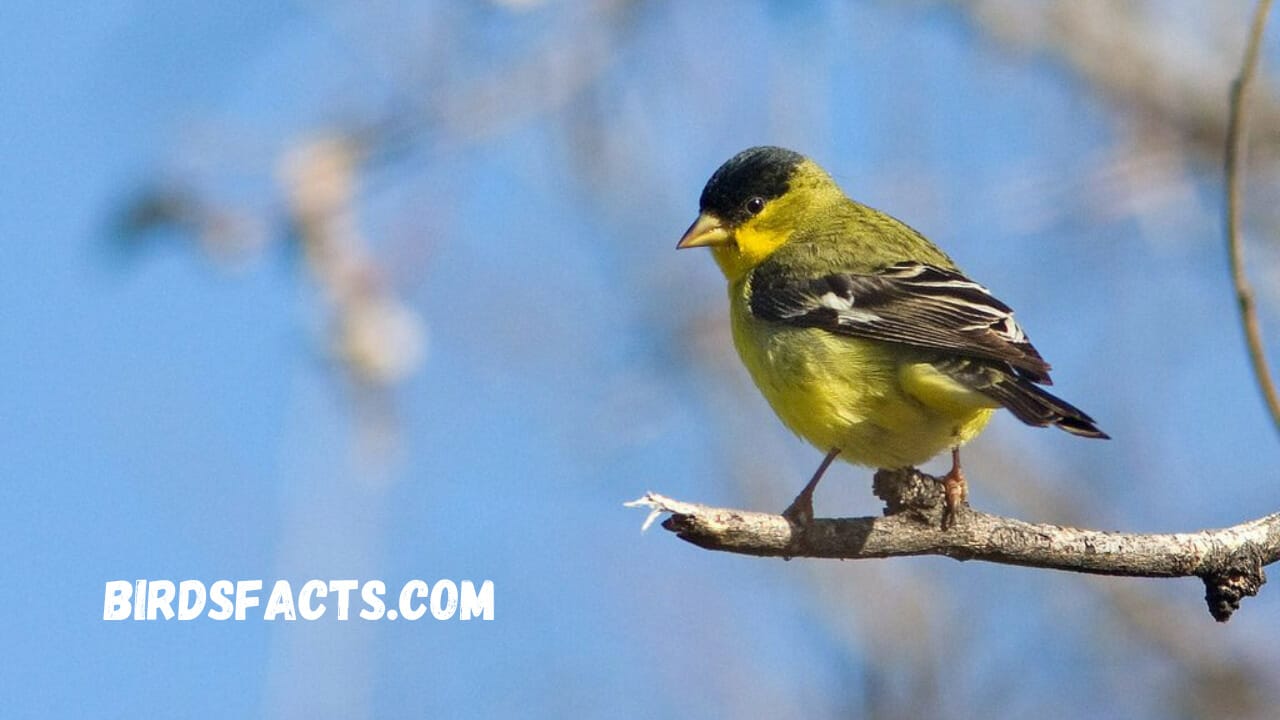
texas finches
The Lesser Goldfinch is a small finch species found throughout North America.
Its scientific name is Spinus psaltria.
The bird’s most distinctive feature is its yellow and black plumage.
Lesser Goldfinches primarily feed on seeds, insects, and other small invertebrates.
The bird’s estimated population size is currently unknown but is believed to be relatively stable.
The biggest threat to Lesser Goldfinches is habitat loss, fragmentation, and competition from other bird species.
The bird’s wingspan is typically around 8-9 inches, while its length ranges from 4-5 inches.
Lesser Goldfinches typically incubate their eggs for around 12-14 days.
The bird’s preferred habitat comprises open woodlands, scrublands, and grasslands.
Predators of Lesser Goldfinches include snakes, hawks, and owls.
The lifespan of a Lesser Goldfinch is typically around 6-8 years.
The bird’s skin type is covered in feathers, while its typical coloration is yellow and black.
Lesser Goldfinches are known for their agile flight and can reach top speeds of around 25 miles per hour.
The bird’s weight is typically around 0.4-0.6 ounces, making it one of the smallest finch species in North America.
| Characteristic | Description |
|---|---|
| Common Name | Lesser Goldfinch |
| Scientific Name | Spinus psaltria |
| Distribution | Throughout North America |
| Plumage | Yellow and black |
| Diet | Seeds, insects, and small invertebrates |
| Population | Estimated population size is unknown but believed to be relatively stable |
| Threats | Habitat loss, fragmentation, and competition from other bird species |
| Wingspan | 8-9 inches |
| Length | 4-5 inches |
| Incubation Period | 12-14 days |
| Preferred Habitat | Open woodlands, scrublands, and grasslands |
| Predators | Snakes, hawks, and owls |
| Lifespan | 6-8 years |
| Skin Type | Covered in feathers |
| Coloration | Yellow and black |
| Flight Characteristics | Agile flight, top speed of around 25 miles per hour |
| Weight | 0.4-0.6 ounces |
Purple Finch (Haemorhous purpureus)
The Purple Finch (Haemorhous purpureus) is a fascinating bird native to North America. This small but resilient bird is known for its beautiful plumage and distinct features, making it a popular sight for bird enthusiasts. With a scientific name that translates to “purple blood,” the Purple Finch has a unique coloration that sets it apart from other bird species.

finch bird texas
This article will delve deeper into the characteristics of the Purple Finch, including its prey, fun facts, estimated population size, the biggest threat, most distinctive feature, other names, wingspan, incubation period, habitat, predators, diet, type, common name, number of species, location, nesting location, age of molting, color, skin type, top speed, lifespan, weight, length, and size.
Despite its name, the Purple Finch is not purple but a reddish-purple hue. Its most distinctive feature is its thick, conical beak for crushing seeds and insects. The Purple Finch primarily feeds on seeds but consumes insects during the breeding season. This bird is considered a type of finch and belongs to the family Fringillidae, which contains over 200 species of finches worldwide.
The Purple Finch is found throughout North America, with most of its population residing in Canada and the United States. Its preferred habitat is forests and woodlands, where it can nest in dense shrubs and trees. However, the biggest threat to its population is habitat loss due to deforestation and urbanization.
The Purple Finch is small, measuring around 5 inches long, with a wingspan of 8-10 inches. They typically live for about 5-7 years and weigh around 0.7-1.1 ounces. During incubation, the female Purple Finch tends to her eggs for about 12-14 days before the chicks hatch. They molt at around 2-3 months of age and are preyed upon by birds of prey such as hawks and owls.
Overall, the Purple Finch is a fascinating bird with a distinct personality and beautiful colors. Despite the threats it faces in its natural habitat, conservation efforts are being made to protect this bird and ensure that it continues to thrive in the wild.
| Characteristics | Information |
|---|---|
| Common Name | Purple Finch |
| Scientific Name | Haemorhous purpureus |
| Other Names | None |
| Type | Bird |
| Family | Fringillidae |
| Number of Species | 1 |
| Location | North America |
| Habitat | Forests and woodlands |
| Nesting Location | Dense shrubs and trees |
| Size | Around 5 inches long |
| Wingspan | 8-10 inches |
| Weight | 0.7-1.1 ounces |
| Color | Reddish-purple |
| Skin Type | Feathers |
| Top Speed | Unknown |
| Lifespan | 5-7 years |
| Incubation Period | 12-14 days |
| Age of Molting | 2-3 months |
| Prey | Seeds, insects during breeding season |
| Predators | Birds of prey (hawks, owls) |
| Biggest Threat | Habitat loss due to deforestation and urbanization |
| Fun Facts | None available |
| Estimated Population Size | Unknown |
Red Crossbill (Loxia curvirostra)
The Red Crossbill (Loxia curvirostra) is a fascinating bird that can be found across the Northern Hemisphere. These finches are known for their unique bill shape, which allows them to extract seeds from conifer cones. The Red Crossbill has a number of interesting features and behaviors that make it a popular subject for birdwatchers and ornithologists alike.
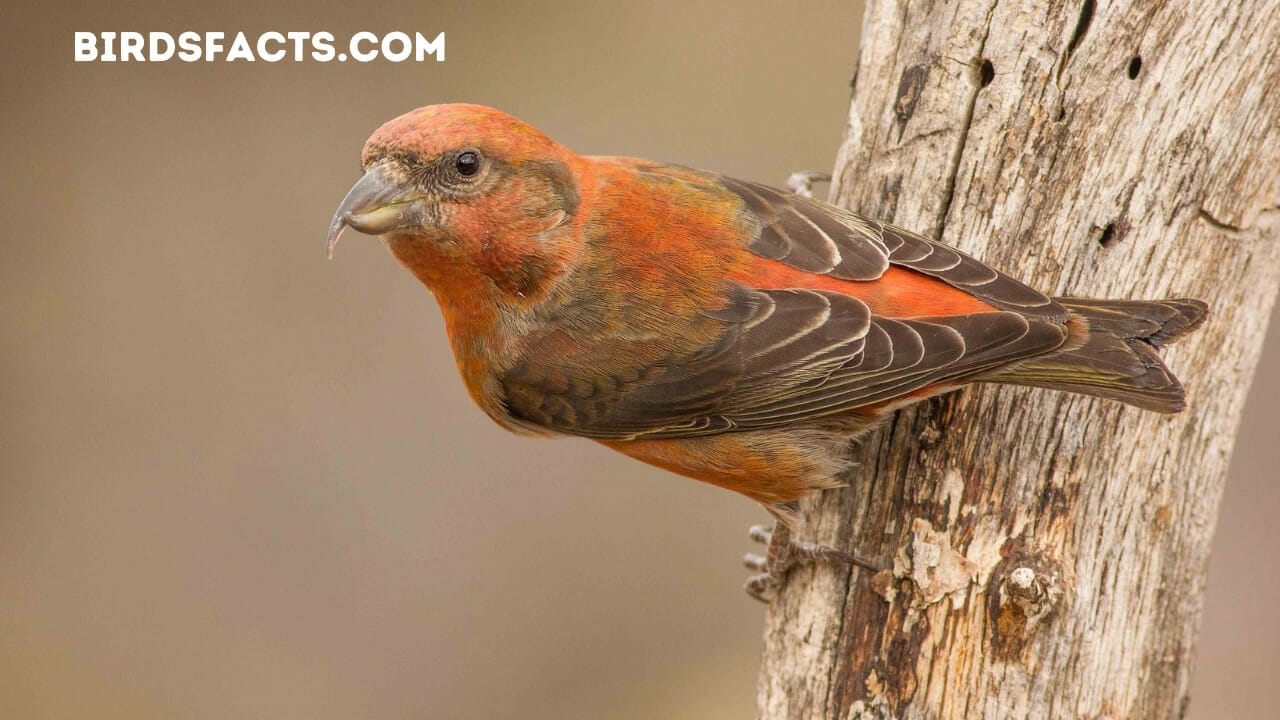
Red Crossbill (Loxia curvirostra)
One of the most distinctive features of the Red Cross bill is its bill. This bird has a unique cross-shaped beak perfectly adapted for extracting cone seeds. The lower mandible is twisted to the right, while the upper mandible is twisted to the left, allowing the bird to grip the cone and extract the seeds easily.
Red Crossbills are preyed upon by a number of predators, including hawks, owls, and snakes. However, they can also defend themselves by forming large flocks and mobbing predators that pose a threat.
Fun fact: Some populations of Red Crossbills have evolved different bill shapes to specialize in extracting seeds from different types of conifers, demonstrating the remarkable adaptability of these birds.
Despite their adaptability, the Red Crossbill faces a number of threats. Habitat loss and fragmentation arencroachesticularly as human development encroaches upon their traditional breeding grounds. Climate change is also a concern, as it can alter the Timiharmcone crops, which could harm Red Crossbill populations.
The Red Crossbill is a medium- with a weight wingspan of around 30-35 cm and a weight of 30-60 g. They typically live for 3-5 years; the incubation period is around 12-16 days, and the birds usually fledge after aro
The Red Crossbill is a type of finch with 11 recognized species worldwide. These birds can be found across North America, Europe, and Asia, each species having its distinctive range and habitat preferences. In North America, the Red Crossbill is found in coniferous forests across much of the continent.
Red Crossbills typically build their nests in conifer trees, using twigs, bark, and lichen to create a cozy, well-camouflaged home. They usually molt once yearly, in the late summer or early fall. Their coloration can vary depending on the subspecies, but most individuals have a distinct red or orange hue.
Overall, the Red Crossbill is a fascinating and unique bird with a number of interesting traits and behaviors. Its distinctive beak, adaptability, and predator defense mechanisms make it a true wonder of the avian world.
| Species | Red Crossbill (Loxia curvirostra) |
|---|---|
| Distribution | Northern Hemisphere; across North America, Europe, and Asia |
| Habitat | Coniferous forests |
| Distinctive Feature | Unique cross-shaped beak, twisted lower mandible to the right and upper mandible to the left |
| Predators | Hawks, owls, snakes |
| Defense Mechanism | Formation of large flocks and mobbing predators |
| Adaptability | Some populations have evolved different bill shapes to specialize in extracting seeds from different types of conifers |
| Threats | Habitat loss and fragmentation due to human development, climate change altering cone crops |
| Size | Medium-sized with a wingspan of approximately 30-35 cm and weight of 30-60 g |
| Lifespan | Typically 3-5 years |
| Incubation Period | Approximately 12-16 days |
| Fledging Time | Around |
| Nest Building | Construct nests in conifer trees using twigs, bark, and lichen |
| Molt | Once a year, usually in late summer or early fall |
| Coloration | Varied depending on subspecies; most individuals have a distinct red or orange hue |
| Populations | 11 recognized species worldwide |
| Interest | Popular subject for birdwatchers and ornithologists |
Pine Siskin (Spinus pinus)
The Pine Siskin (Spinus pinus) is a small bird with a big personality. Known for its distinct features and unique feeding habits, this species is a favorite among birdwatchers and nature enthusiasts. With a scientific name that pays homage to its preferred habitat, this bird can be found in the pine forests of North America.
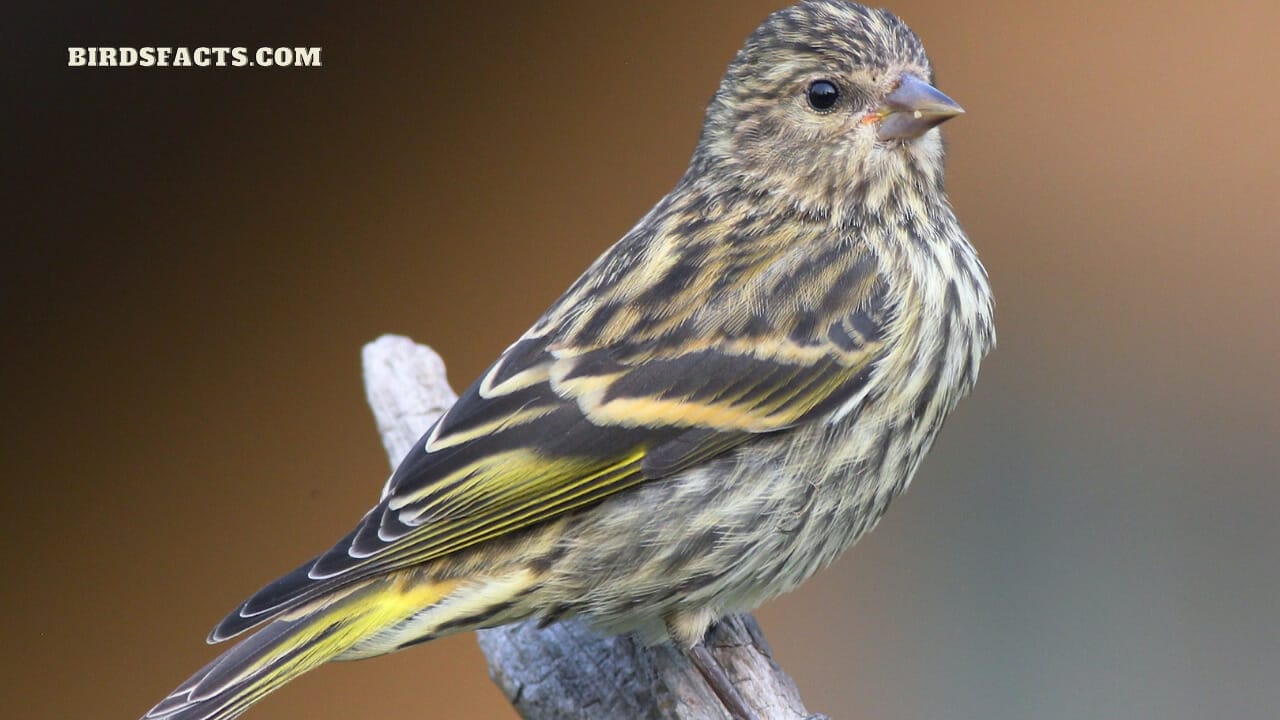
Pine Siskin (Spinus pinus)
The Pine Siskin is a small passerine bird belonging to the finch family known for its vibrant plumage. Despite its small size, this species is a formidable hunter, feeding on various seeds and insects. Interestingly, Pine Siskins are a nomadic species, meaning they do not have a permanent home and can be found in various habitats.
One of the most distinctive features of the Pine Siskin is its wingspan, which can range from 7 to 9 inches. They are also known for their distinctive yellow markings on their wings and tails. Regarding habitat, Pine Siskins prefer to nest in coniferous trees, specifically pine trees.
While they are a beloved bird species, Pine Siskins face a number of challenges in the wild. Their biggest threat comes from habitat loss and fragmentation, which reduces their ability to find food and nesting sites. Additionally, they face predation from larger animals such as hawks and falcons.
Despite these challenges, Pine Siskins are still a relatively common sight in North America, and current estimates put their population size at around 20 million individuals. One fun fact about Pine Siskins is that they are known to the group in large flocks during winter, demonstrating their social nature and ability to adapt to changing conditions.
Whether you’re a seasoned birdwatcher or just starting, the Pine Siskin is a fascinating species to observe in the wild. With their vibrant colors and unique feeding habits, these birds will capture your attention and leave a lasting impression.
| Species Name | Pine Siskin |
|---|---|
| Scientific Name | Spinus pinus |
| Description | A small bird with a big personality, known for its distinct features and unique feeding habits. |
| Habitat | Pine forests of North America |
| Size | Small |
| Family | Finch |
| Feeding Habits | Feeds on various seeds and insects |
| Nomadic Behavior | Does not have a permanent home and can be found in various habitats |
| Wingspan | 7 to 9 inches |
| Distinctive Features | Vibrant plumage, yellow markings on wings and tails |
| Nesting Preferences | Coniferous trees, specifically pine trees |
| Threats | Habitat loss and fragmentation, predation by larger animals |
| Population Size | Around 20 million individuals |
| Social Behavior | Known to group in large flocks during winter |
| Interesting Fact | Beloved by birdwatchers and nature enthusiasts for their vibrant colors and unique feeding habits |
American Goldfinch (Spinus tristis)
The American Goldfinch (Spinus tristis) is a bright and colorful bird easily recognizable thanks to its vibrant yellow and black plumage. This small songbird is a common sight across much of North America, where it can be found in fields, forests, and gardens. With its distinctive appearance and pleasant song, the American Goldfinch is a favorite among birdwatchers and nature lovers.
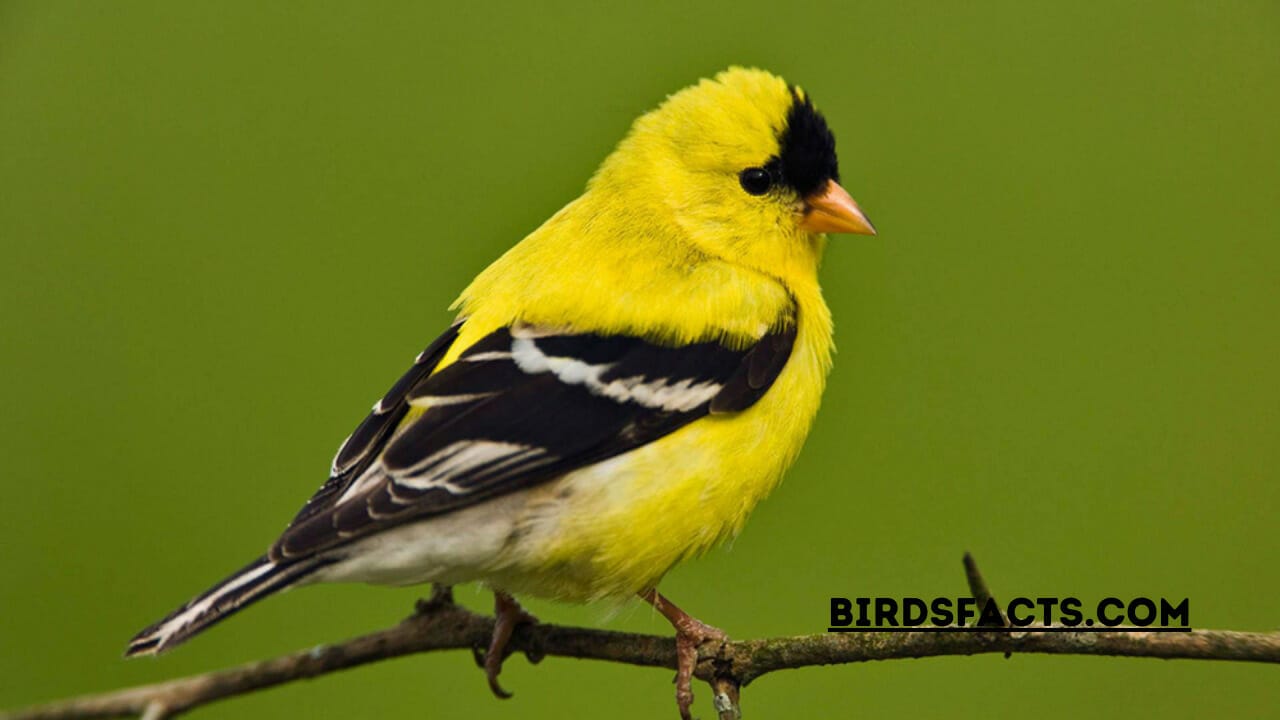
American Goldfinch (Spinus tristis)
Scientifically known as Spinus tristis, the American Goldfinch is part of the finch family, which includes several other brightly colored species. These birds are slender, with a pointed bill and a forked tail that is distinctive in flight. They also have a distinctive undulating flight pattern, which adds to their charm.
One of the most distinctive features of the American Goldfinch is its plumage. The male’s breeding plumage is bright yellow with black wings and tail feathers, while the female is a more subdued olive-yellow. Both sexes have black foreheads and black wings with white wing bars. During the non-breeding season, the male plumage will fade to more olive color, making it less striking than its breeding colors.
The American Goldfinch is primarily herbivorous, with a diet that consists largely of seeds. They are especially fond of thistle and sunflower seeds and often visit bird feeders to snag a meal. They occasionally eat insects, but these only make up a small part of their diet.
Despite being a common sight across much of North America, the American Goldfinch faces several threats to its survival. Loss of habitat due to human development is a major concern, as is predation by cats and other predators. Climate change may also pose a threat, as changes in weather patterns could affect the availability of the food sources the bird relies on.
Despite these challenges, the American Goldfinch is still a relatively common bird, with an estimated population of around 42 million. It’s distinctive appearance and pleasant song make it a favorite among bird lovers and nature enthusiasts alike.
| Species Name | American Goldfinch (Spinus tristis) |
|---|---|
| Description | A bright and colorful bird with vibrant yellow and black plumage. |
| Habitat | Fields, forests, and gardens across North America. |
| Appearance | Slender bird with pointed bill and forked tail. Distinctive undulating flight pattern. |
| Plumage | Male: Bright yellow with black wings and tail feathers. Female: Subdued olive-yellow. Black foreheads and wings with white wing bars. |
| Diet | Primarily herbivorous, consuming seeds (thistle and sunflower) with occasional insects. |
| Threats | Loss of habitat, predation by cats and other predators, potential impact of climate change. |
| Population | Estimated population of around 42 million. |
| Status | Relatively common bird. |
| Attraction | Favorite among birdwatchers and nature lovers due to distinctive appearance and pleasant song. |
Evening Grosbeak (Hesperiphona vespertinus)
The Evening Grosbeak, scientifically known as Hesperiphona vespertinus, is a colorful bird species native to North America. This bird species is known for its bright and striking plumage, making it a popular sight for birdwatchers and novice nature enthusiasts alike. The Evening Grosbeak is a large finch-like bird that belongs to the Fringillidae family of songbirds.
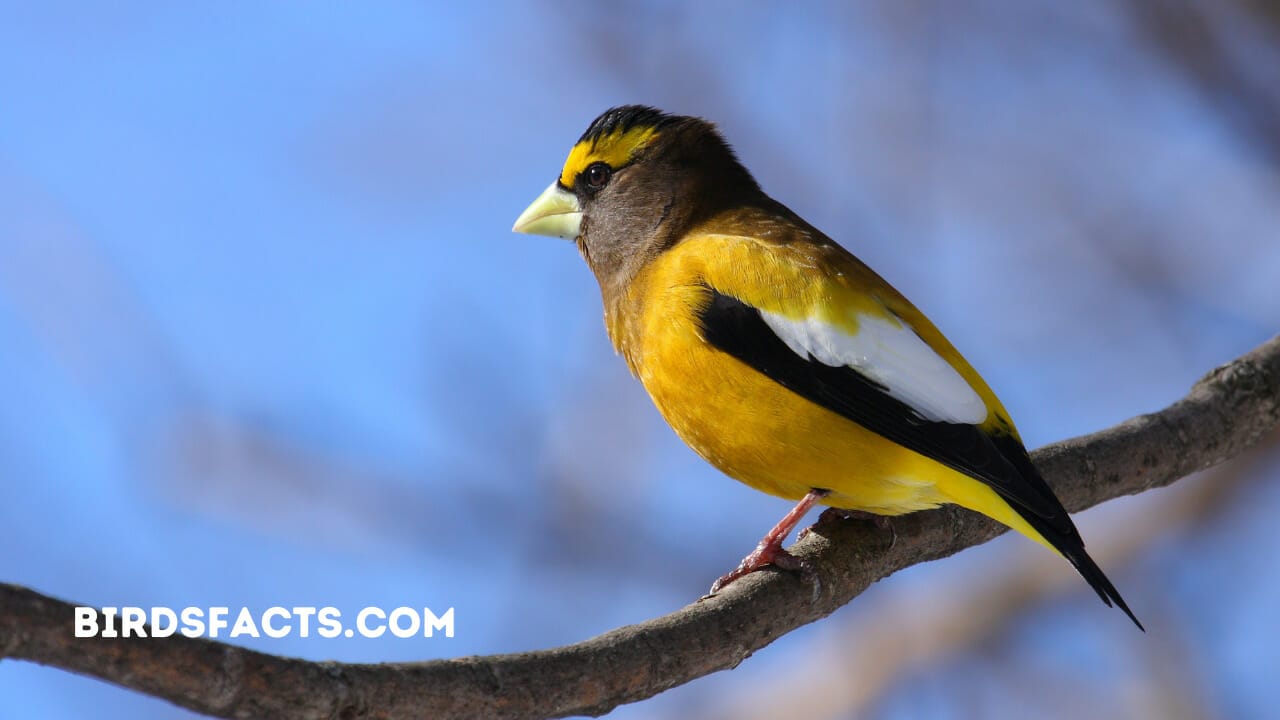
Evening Grosbeak (Hesperiphona vespertinus)
These unique birds have a lot of interesting qualities that make them stand out in the avian world. They have a diverse diet, including various seeds, fruits, and insects, and they also have a distinctive chirp and call. Additionally, their lifespan can range from 3-10 years in the wild, making them a beloved sight for years.
Despite their popularity, the Evening Grosbeak population has declined in recent years. Their biggest threat comes from habitat loss, fragmentation, and climate change. This decline has led to conservation efforts to protect and preserve their habitats.
To learn more about the Evening Grosbeak, keep reading to discover its unique characteristics, habitat, diet, and more.
| Species Name | Evening Grosbeak |
|---|---|
| Scientific Name | Hesperiphona vespertinus |
| Description | Colorful bird species native to North America |
| Plumage | Bright and striking |
| Bird Family | Fringillidae |
| Diet | Seeds, fruits, insects |
| Chirp and Call | Distinctive |
| Lifespan | 3-10 years (in the wild) |
| Population Status | Declining |
| Threats | Habitat loss, fragmentation, climate change |
| Conservation Efforts | Ongoing conservation efforts to protect and preserve their habitats |
Juvenile Black-headed Grosbeak (Pheucticus melanocephalus)
The Black-Headed Grosbeak, scientifically known as Pheucticus melanocephalus, is a striking bird with a unique appearance that easily captures the eye of birdwatchers. This intelligent bird species belong to Cardinalidae – the cardinal family – and is closely related to the familiar Cardinals or Pyrrhuloxia.

Juvenile Black-headed Grosbeak (Pheucticus melanocephalus)
The Black-Headed Grosbeak is a common sight in the western regions of North America, where it’s known for its distinctive appearance and melodious song. This bird is quite sizable, measuring up to 20 cm in length and weighing up to 52 grams, making it one of the larger members of the Finch family.
This bird species is known for its unique features and habits, such as its preferred diet of insects, seeds, and fruits, nesting in shrubs and bushes, and preying on small insects. To learn more about this fascinating bird species, let’s dive into some of its key characteristics:
- Prey: insects, seeds, and fruits
- Fun Fact: the Black-Headed Grosbeak has a beautiful, melodic singing voice and can learn to mimic other bird songs
- Estimated Population Size: 20 million individuals
- Biggest Threat: habitat loss and fragmentation due to deforestation and human expansion
- Most Distinctive Feature: a black head, white underparts, and a reddish-brown back
- Other Name(s): none
- Wingspan: 30 cm
- Incubation: 11 to 14 days
- Habitat: found in forests, woodlands, and riparian areas in the western United States, Canada, and Mexico
- Predators: snakes, squirrels, raccoons, and birds of prey
- Diet: insects, seeds, and fruits
- Type: bird
- Common Name: Black-Headed Grosbeak
- Number Of Species: one
- Location: western United States, Canada, and Mexico
- Nesting Location: shrubs and bushes
- Age of Molting: 10 to 14 days
- Color: black, white, and reddish-brown
- Skin Type: feathers
- Top Speed: unknown
- Lifespan: up to 11 years
- Weight: up to 52 grams
- Length: up to 20 cm
With its bold and colorful plumage, the Black-Headed Grosbeak is a delight for bird and nature enthusiasts alike. Though it faces numerous threats, the population of this bird species remains stable for now thanks to conservation efforts aimed at protecting its natural habitat.
Blue Grosbeak (Passerina caerulea)
The Blue Grosbeak (Passerina caerulea) is a beautiful bird in North and Central America. This bird is a member of the Cardinal family and is known for its distinctive blue plumage. With an estimated population size of around 3.8 million individuals, the Blue Grosbeak is considered a common species.

Blue Grosbeak (Passerina caerulea)
One of the most distinctive features of the Blue Grosbeak is its beak. This bird has a thick, conical beak used to crack open seeds and nuts. The Blue Grosbeak is also known for its brightly colored feathers, predominantly deep blue.
Despite its relatively large population size, the Blue Grosbeak faces several threats. One of the biggest threats to this bird is habitat destruction and fragmentation. As more and more land is developed for human use, the Blue Grosbeak is losing the forests and woodlands it needs to survive.
The Blue Grosbeak is a fascinating bird with a number of interesting characteristics. For example, this bird’s wingspan measures approximately 10 inches and typically weighs around 0.8 ounces. The Blue Grosbeak is omnivorous, feeding on insects, fruit, and seeds.
In terms of habitat, the Blue Grosbeak is found in open woodlands, forest edges, and thickets. This bird prefers areas with a lot of vegetation and sometimes builds its nest in tall grasses or shrubs. The young are typically born with gray-brown plumage and will begin molting into their bright blue feathers after about 60 days.
Overall, the Blue Grosbeak is a fascinating and beautiful bird worth learning more about. Whether you’re a birdwatcher or simply someone who appreciates the beauty of nature, the Blue Grosbeak will surely capture your attention.
| Species Name | Blue Grosbeak (Passerina caerulea) |
|---|---|
| Description | A beautiful bird found in North and Central America. Member of the Cardinal family. Known for its distinctive blue plumage. |
| Population Size | Approximately 3.8 million individuals |
| Beak | Thick, conical beak used to crack open seeds and nuts |
| Feathers | Predominantly deep blue |
| Threats | Habitat destruction and fragmentation |
| Characteristics | Wingspan: Approximately 10 inches<br>Weight: Around 0.8 ounces<br>Diet: Omnivorous – insects, fruit, and seeds |
| Habitat | Open woodlands, forest edges, and thickets with abundant vegetation |
| Nesting | Nests built in tall grasses or shrubs |
| Plumage | Young: Gray-brown initially, molting into bright blue feathers after around 60 days |
| Overall | A fascinating and beautiful bird that captures attention |
Rose-Breasted Grosbeak (Pheucticus ludovicianus)
The Rose-Breasted Grosbeak (Pheucticus ludovicianus) is a captivating bird species in North America and Mexico. Its striking pink and black coloring makes it hard to miss this stunning creature. Known for its powerful bill, this bird is a master hunter, catching insects, seeds, and sometimes even small animals as prey.
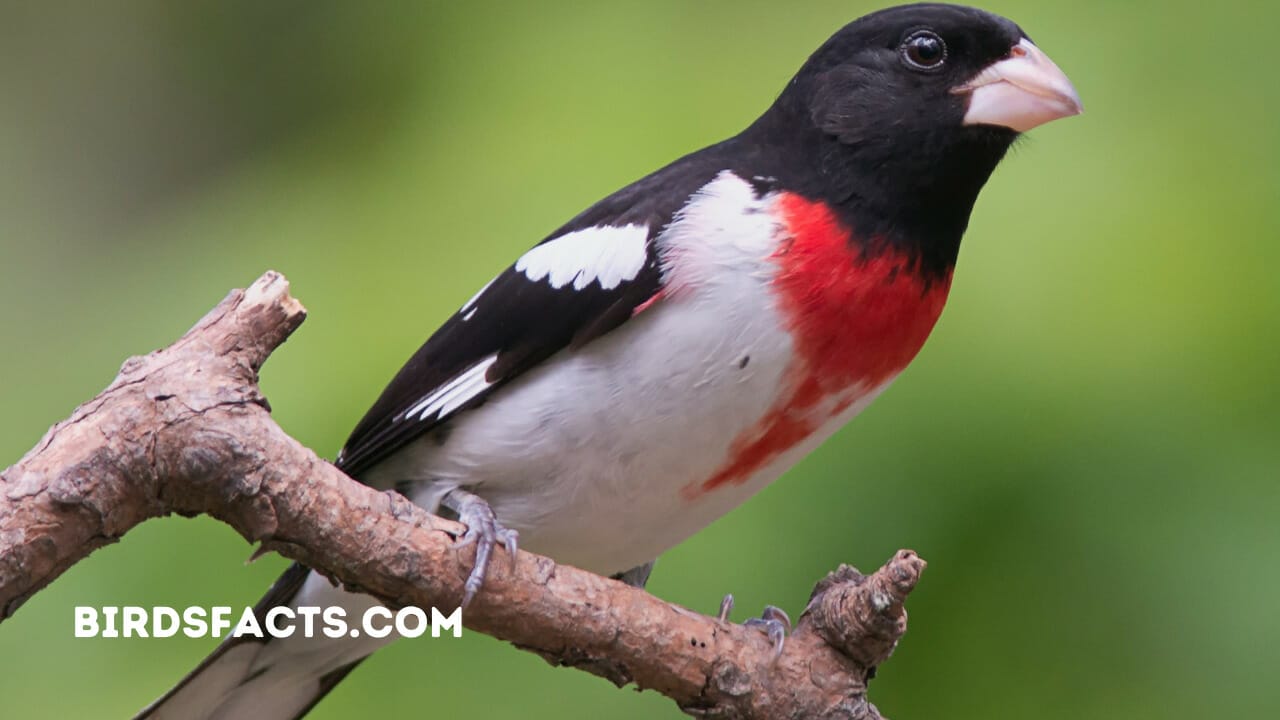
Rose-Breasted Grosbeak (Pheucticus ludovicianus)
Fun Fact: Did you know that male and female Rose-Breasted Grosbeaks have distinct coloring? Males have striking rose-colored breasts, while females have a more subdued yellow-brown.
Despite its beauty, the Rose-Breasted Grosbeak faces several threats. Habitat loss and degradation, climate change, and collisions with windows and other artificial structures are all major risks to this bird’s survival.
Estimated to have a population size of around 8 million individuals, the Rose-Breasted Grosbeak is listed as a species of Least Concern by the International Union for Conservation of Nature.
This bird’s most distinctive feature is its stunning rose-colored breast, which is a surefire way to identify it in the wild. It’s also sometimes called the “Rainbow Bird” due to its vivid colors and the fact that it’s a migratory species, moving between North and South America twice a year.
Other unique features include its large wingspan of approximately 12 inches and its incubation period of around 11 days, during which the male and female sit on the eggs.
Rose-Breasted Grosbeaks prefer to live in deciduous forests and woodlands but can also be found in suburban areas with large trees nearby. Their predators include hawks, snakes, and squirrels.
As omnivores, their diet is varied but typically consists of insects, seeds, and fruits. They are classified as passerines, a type of perching bird, and there are at least 43 species of grosbeaks worldwide.
The Rose-Breasted Grosbeak is a captivating bird species with unique coloration and impressive hunting skills. With proper conservation efforts, this bird has the potential to thrive and continue to enchant birdwatchers for years to come.
Common Redpoll ( Acanthis )
The Common Redpoll, scientific name Acanthis, is a small finch that is found throughout the circumpolar regions of North America and Eurasia. Its prey mainly consists of seeds from various trees and plants. A fun fact about the Common Redpoll is their unique method of digesting seeds. Their muscular pouch in their esophagus allows them to store seeds, which they grind with specialized chewing muscles before digesting.

Common Redpoll
The estimated population size of the Common Redpoll is around 60 million individuals globally. However, their biggest threat is climate change, which may affect their breeding success and winter survival. The most distinctive feature of the Common Redpoll is their red forehead and black bibs. They are also commonly referred to as the Arctic Redpoll or Mealy Redpoll. The wingspan of this bird is about 8 inches, and the incubation period for their eggs is around 12-13 days. The Common Redpoll is found in various habitats, including tundra, boreal forest, and alpine areas.
Predators of the Common Redpoll include owls and hawks. Their diet consists mainly of seeds, but they also occasionally consume insects during summer. The Common Redpoll is a type of finch and is one of the 7 species within the genus Acanthus. They are found in northern North America and Europe, including parts of Canada, Alaska, and Scandinavia. The Common Redpoll nests in evergreen and deciduous trees or shrubs, and their molting typically occurs at around 6 months.
They come in shades of brown and grey, with males displaying red foreheads and black bibs. The Common Redpoll has a lifespan of around 2-3 years, weighs about 10-15 grams, and has a length of around 12 centimeters.
| Common Redpoll | |
|---|---|
| Scientific Name | Acanthis |
| Description | Small finch found in circumpolar regions of North America and Eurasia |
| Prey | Seeds from various trees and plants |
| Digestion | Unique method using muscular pouch in esophagus for seed storage and grinding |
| Population Size | Approximately 60 million individuals globally |
| Threats | Climate change affecting breeding success and winter survival |
| Distinctive Features | Red forehead and black bibs |
| Other Names | Arctic Redpoll, Mealy Redpoll |
| Wingspan | 8 inches |
| Incubation Period | 12-13 days |
| Habitats | Tundra, boreal forest, alpine areas |
| Predators | Owls, hawks |
| Diet | Mainly seeds, occasional insects during summer |
| Genus | Acanthis (one of the 7 species) |
| Distribution | Northern North America and Europe (Canada, Alaska, Scandinavia) |
| Nesting | Evergreen and deciduous trees or shrubs |
| Molting | Occurs at around 6 months |
| Colors | Shades of brown and grey; males have red foreheads and black bibs |
| Lifespan | Around 2-3 years |
| Weight | 10-15 grams |
| Length | Around 12 centimeters |
Conclusion
Discovering the diverse world of finches in Texas offers an exciting opportunity to appreciate nature’s beauty and understand the importance of habitat conservation. By identifying different finch species and attracting them to our backyard, we can create a welcoming haven for these charming birds. Let’s continue to celebrate the splendor of finches and take action to protect their populations for generations to come.
FAQs
Do Finches live in Texas?
Yes, they do. Several species of finches can be found throughout Texas, including the House Finch, Pine Siskin, and American Goldfinch. These small birds are known for their colorful feathers and distinctive songs and can be seen in parks, gardens, and backyards throughout the state.
What do Texas House Finches eat?
Texas House Finches typically eat insects, seeds, and berries. They have strong, cone-shaped bills which help them crack open tough seeds. They also have a preference for sunflower seeds, thistle, and millet. However, their diet typically consists of insects and larvae during the breeding season. Overall, the Texas House Finch is an omnivore whose diet varies based on food availability in its environment.
What are the small green finches in Texas?
What are the small green finches in Texas? These little birds are known as the green singer or green-backed finch. They are common in Texas and can be found in urban and rural habitats. With their vibrant green plumage and distinctive songs, these finches are a popular sight among birdwatchers and nature enthusiasts alike. However, they can also become a nuisance to farmers as they prefer agricultural areas such as orchards and vineyards.
Are there yellow Finches in Texas?
The answer is yes. Two species of yellow Finches can be found in Texas: the American goldfinch and the Lesser goldfinch. These birds are commonly seen in the state, especially during the spring and summer, when they breed and raise their young. They can be spotted in various habitats, from suburban gardens to rural fields and meadows. Their bright yellow plumage and cheerful songs make them a favorite among birdwatchers and nature enthusiasts.
What bird is Texas known for?
Texas is known for the Northern Mockingbird, designated as the state bird in 1927. These birds are found throughout the state and are recognized for their beautiful singing voices. They are also known for their mimicking abilities, as they can imitate the sounds of other birds and even some manufactured sounds. The Northern Mockingbird is a beloved symbol of Texas and a popular sight for birdwatchers.
Further Reading
You may also check out:
Thank you for reading!








